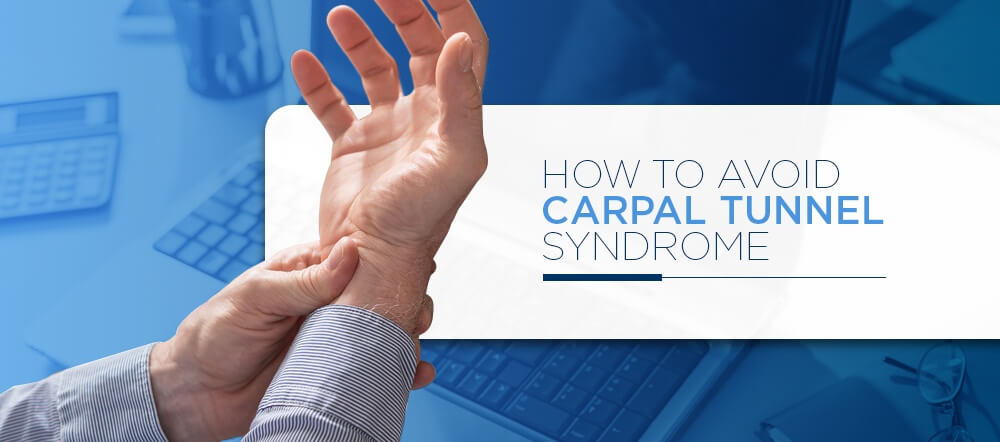
If you notice a sharp pain shooting through your wrist, you might think it’s nothing more than a cramp. But if you continue to experience discomfort in your hands and wrists, you might begin to wonder if you have carpal tunnel syndrome.
Carpal tunnel syndrome (CTS) is a condition that affects as much as 6% of the adult population. CTS usually occurs only in adults, and it is more common in women than in men. Although CTS is not life-threatening, it can be debilitating if left untreated. Fortunately, it is possible to seek treatment for this condition before it leads to permanent damage.
The first step to treating carpal tunnel syndrome is to determine whether you have it. In this post, we’ll explain CTS, how it feels and steps you can take to avoid symptoms. If you have any questions, please don’t hesitate to contact us at (301) 530-1010.
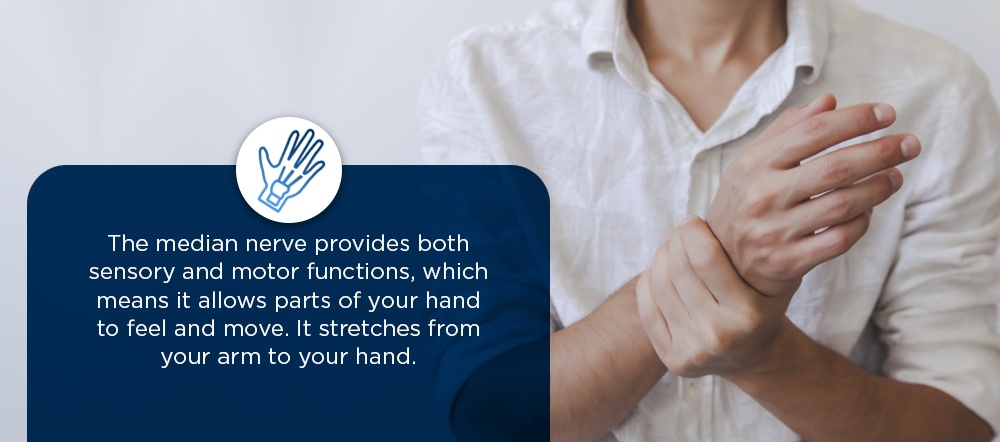
What Is Carpal Tunnel Syndrome?
Carpal tunnel syndrome develops when the median nerve in your wrist becomes pinched or compressed. The median nerve provides both sensory and motor functions, which means it allows parts of your hand to feel and move. It stretches from your arm to your hand. The nerve enters your hand through a narrow channel in your wrist called the carpal tunnel. When the tunnel becomes swollen, which may be due to several reasons, it can pinch the median nerve. The pinched nerve leads to pain, numbness or weakness in the wrist and hand.
What Is the ICD-10 Code for Carpal Tunnel Syndrome?
Health care workers may be interested to know the code for carpal tunnel syndrome according to the International Classification of Diseases, 10th Revision (ICD-10). The health care field uses ICD codes to process claims, track public health conditions and complete a wide range of other data-related tasks. In the ICD-10, carpal tunnel syndrome has the code G56.0, under nerve disorders.
What Are Carpal Tunnel Syndrome Symptoms?
Typically, the symptoms of carpal tunnel syndrome come on gradually. Someone with CTS might first notice tingling or numbness in their thumb or fingers. Some individuals may feel like they cannot use their fingers to grasp something. Symptoms usually appear at night and may be present in both hands. For example, you might find yourself waking up to shake out your hands, which can temporarily relieve symptoms.
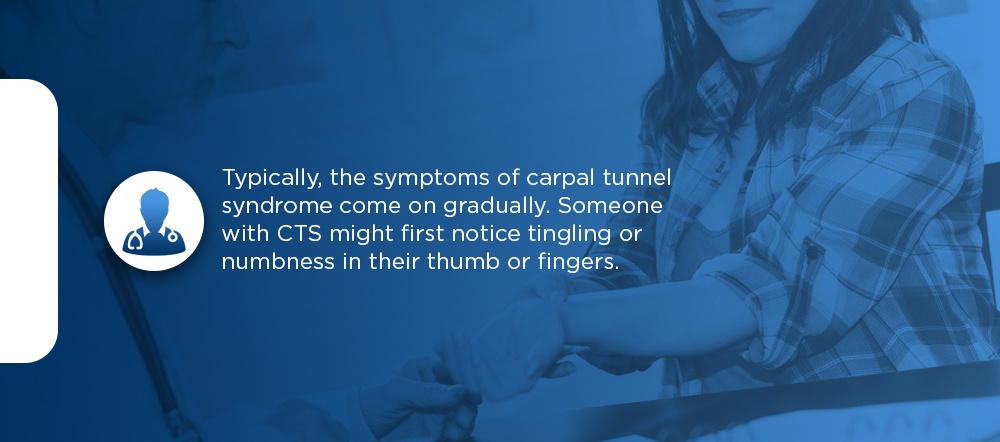
If symptoms worsen over time, you might notice tingling in your fingers when you engage in activities like driving or reading. Your hands might also feel weak, making it challenging to complete tasks like writing or handling small objects. Many patients complain of having difficulty carrying bags, for example. With severe CTS, you may lose sensation in your fingertips or the ability to move your thumbs and fingers like you used to. The symptoms of severe CTS are more constant. Overall, if you have CTS, you may experience the following symptoms:
- Pain in the wrist and hand that may extend to the elbow
- Tingling, numbness or pain in the thumb and fingers, except for the little finger
- Issues with hand coordination
- Hand weakness
- Symptoms that worsen when bending the wrist forward
What Are the Signs of Carpal Tunnel Syndrome?
CTS is not usually something you can see with an untrained eye. However, if you notice yourself or a loved one commonly dropping objects in addition to experiencing hand numbness or pain, it may be a sign of carpal tunnel syndrome. Only in severe cases will the thumb muscles visibly shrink.
Which Symptom May Be Helpful in Identifying Carpal Tunnel Syndrome?
People often confuse carpal tunnel syndrome with conditions that cause similar symptoms, like arthritis, for example. However, arthritis, which is inflammation of the joints, can affect all the fingers, whereas CTS typically does not impact the pinky finger. Your doctor may perform the following tests to determine if you have CTS or another ailment:
- Tap on your median nerve to watch if it causes pain
- Bend your wrist forward for 60 seconds to see if it causes tingling, numbness or weakness
Either of these tests may show signs of CTS.
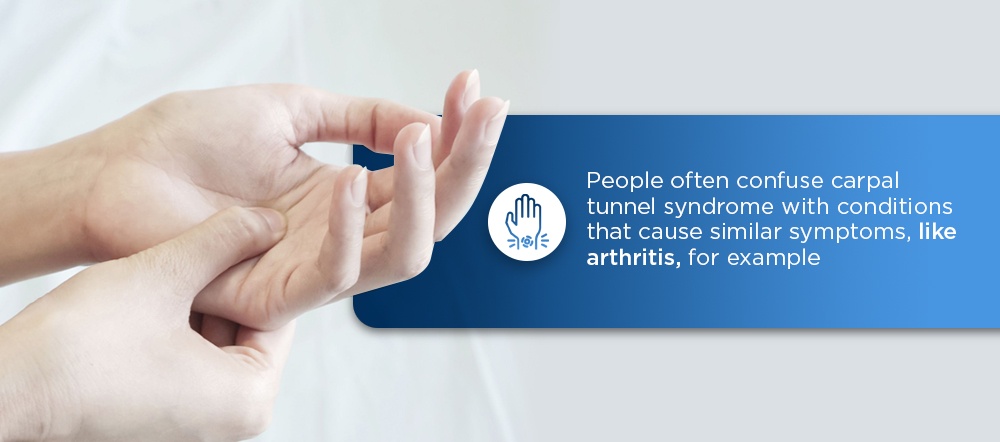
What Causes Carpal Tunnel Syndrome?
It is usually challenging to identify a single cause for carpal tunnel syndrome. Typically, CTS is a result of several factors combined, such as an injury to the wrist and repetitive motions. In general, anything that irritates the median nerve may cause CTS.
Who Is at Risk for Carpal Tunnel Syndrome?
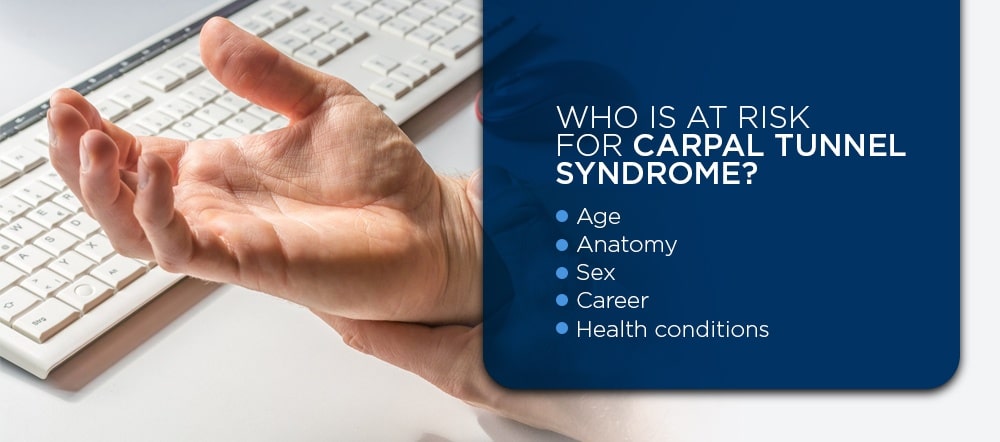
While anyone can get CTS, there are specific risk factors associated with the condition.
- Age: CTS is more common in adults over age 30 than other age groups.
- Anatomy: Some individuals are born with small carpal tunnels in their wrists, which can increase the chance of getting CTS.
- Sex: Women are much more likely to get CTS than men. Pregnancy can also be a risk factor for CTS, particularly in women who retain fluids.
- Career: People who have jobs that involve repetitive movements or working with tools may face a higher risk of CTS.
- Health conditions: Underlying conditions such as arthritis, gout, diabetes, alcoholism and hypothyroidism may make someone more susceptible to CTS.
How Do You Prevent Carpal Tunnel Syndrome?
Since a combination of factors may cause CTS, it’s hard to determine exact prevention methods. Fortunately, there are many strategies you can try to keep symptoms from getting worse.
5 Ways to Avoid Carpal Tunnel Syndrome
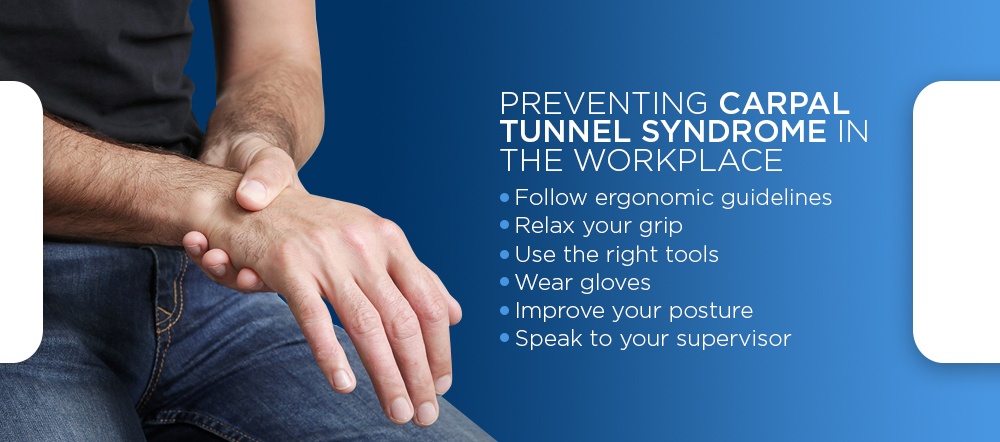
There are several ways to reduce your risk of developing CTS or more severe symptoms. Here are some broadly applicable tips, whether you’re at home or work.
- Wear a wrist brace: A wrist brace can help you keep your wrist straight as you sleep or perform repetitive tasks. Many people bend their wrists while they sleep, which squeezes the median nerve. When you take the brace off, make sure to move your wrist as you naturally would to maintain strength and flexibility, but avoid putting too much stress on it. Wearing a wrist brace, also known as a splint, can help relieve symptoms.
- Avoid repetition: If possible, try not to make repetitive motions and mix up tasks when you can. This tip is especially relevant to movements that involve flexing your wrists. You might switch to your left hand to give your right a break, for example.
- Take breaks: If you need to do repetitive activities, try to take short breaks as often as possible, or at least once an hour. You might set an alarm, so you don’t forget.
- Stretch throughout the day: During your breaks, or ideally, every 20 minutes, do a stretching exercise. Here’s a simple stretch you can try. Make a fist, then release your fingers and stretch them out as far as possible. Repeat this stretch five to 10 times.
- Visit your doctor: It’s best not to wait to treat carpal tunnel syndrome and allow the condition to get worse. If you’re experiencing pain or numbness in your hand, visit your doctor so they can make an accurate diagnosis and treat you accordingly.
3 Tips for Avoiding Carpal Tunnel When Working From Home

Remote work is on the rise. However, if you’re like many people working from home, you might not have the best setup for your residential office. Additionally, your working habits could lead to a condition known as carpal tunnel syndrome.
Carpal tunnel syndrome is caused by repetitive, stressful motions of the hands. Try the following at-home tips to reduce your chances of developing and being diagnosed with this common physical concern among office workers.
1. Set Up Your Desk to Avoid Carpal Tunnel Syndrome
Are you working at your dining room table or sitting on the sofa with your laptop? You may be putting yourself at risk of developing carpal tunnel syndrome.
What you need is an ergonomically sound office workspace. Invest in an office desk and suitable chair that can adjust to a comfortable height so your eyes are level with your laptop or desktop screen. With this setup, you’ll be comfortable typing, conducting Zoom meetings or reading documents for hours at a time from your space.
2. Buy Desk Accessories Designed to Prevent Carpal Tunnel Syndrome
You may notice that many desk accessories such as curved keyboards and mouses tout their ergonomic ability. You can give a few of these accessories a try to determine if they help your hands, wrists and fingers feel better after a busy day.
Other amenities you can use include special armrests, headrests and wrist rests. If you’re working with an orthopedic doctor, your doctor may recommend wearing a hand splint.
3. Address Signs of Creeping Carpal Tunnel Syndrome Pain Right Away
At the end of the day, your hands and wrists may feel tingly or uncomfortable. These symptoms can be the early warning signs of impending carpal tunnel syndrome. Instead of ignoring the signs, you can start incorporating stretch breaks into your daily routine to reduce their impact. Every hour or so, spend three minutes massaging your hands, wrists and forearms. You may even place your hands under a warm blanket or therapeutic hot pad to help reduce tension in your hands and arms.
Preventing Carpal Tunnel Syndrome in the Workplace
If your job requires you to use your hands for a long time in an unnatural position or while using force, you’re at higher risk of developing carpal tunnel syndrome. However, CTS doesn’t only affect employees with manufacturing jobs. Many different occupations, from grocery store jobs to administrative positions, could put an employee at risk of developing CTS. By adjusting the way you work, you may be able to avoid carpal tunnel syndrome, reduce the severity of symptoms or make them disappear completely. Consider these tips.
- Follow ergonomic guidelines: The first step to avoiding work-related CTS is to consider your work setup. If you are spending the day in a position that’s not ergonomically correct, you could be putting extra strain on your wrist. A few simple adjustments may be all you need to bypass CTS. If you work at a desk, for example, consider how you have set up your chair, monitor and keyboard. Position the keyboard so you don’t have to bend your wrists. Adjust your chair or desk so you can keep your elbows close to your sides as you type. The point of ergonomics is to reduce the stress you put on your body. Workers in all settings should follow ergonomic guidelines.
- Relax your grip: Pay attention to how you use your hands. Do you catch yourself gripping your phone or pen too tightly? If so, practice relaxing your grip or holding objects in a way that puts less strain on your wrist. If you spend the day typing or working at a cash register, try to hit the keys lightly. If your job involves frequent handwriting, using a larger pen can help you write more loosely.
- Use the right tools: If you work with vibrating tools for a prolonged time, you could be putting too much pressure on your median nerve. Make it a point to take a 10-minute break at least once an hour and to use tools that fit your hand correctly. Also, use the most efficient tools you have access to, to reduce the amount of force you need to apply. When using tools, make sure your wrist lines up with your hand and forearm.
- Wear gloves: Fingerless gloves can help keep your hands warm, which can reduce pain and stiffness. This piece of advice can be particularly helpful if you work in a cold environment. If you work with vibrating tools, wear anti-vibration gloves when possible.
- Improve your posture: Poor posture puts stress on your entire body, from your neck to your fingers, and can cause pain. Proper positioning allows all your body parts to align correctly. If you sit at work, don’t cross your legs, and keep your feet flat on the floor. Your upper back should be straight, and your chair should support your lower back. If you stand, keep your feet about shoulder-width apart and your back straight.
- Speak to your supervisor: If your job seems to be making CTS symptoms worse, ask your manager if you can adjust your workspace or switch duties. Perhaps you can rotate tasks with a co-worker, or perform your job differently, so you are not completing repetitive motions for long periods.
How to Prevent Carpal Tunnel Syndrome While Gaming
Although gaming injuries are rare, they do occur occasionally, and they can happen at any age. Personal computer gamers who use a keyboard and a mouse may be more at risk of experiencing carpal tunnel syndrome than those who use video controllers. In either case, you should speak with your doctor if you notice pain during gaming, or have symptoms that last for several days. Here are tips to help you game safely and avoid CTS.
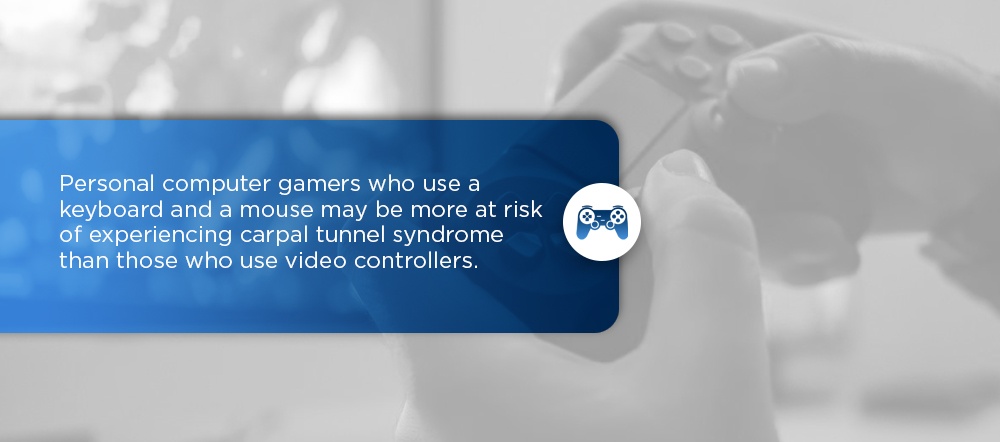
- Change your mouse: If using your mouse causes wrist pain or isn’t comfortable, it’s time to try a different one. For example, you might try a vertical mouse or one designed especially for gamers. Test your new device for a week and see if it helps.
- Take breaks: Gamers must remember to take breaks, so they can fit in some physical activity and give their hands a rest. When playing, you should pause at least once an hour. Every two hours, get up to stretch and move around to prevent back problems and improve circulation.
- Sit correctly at your computer: You should not need to bend your wrists while you use your computer. Adjust the height of your desk or chair to make sure you can keep your wrists straight and your elbows at your side. The top of your monitor should be at eye level, and you should be able to sit with your feet flat on the floor. Make whatever adjustments you need to reduce the stress you put on your body as you game.
Carpal Tunnel Syndrome Stretching
You can help relieve pressure on the median nerve and prevent symptoms by combining carpal tunnel exercises and stretches with other treatments, like wearing a splint. You may wish to speak with your doctor before trying a new stretch or exercise. If you notice pain as you stretch, stop what you’re doing and let your doctor know.
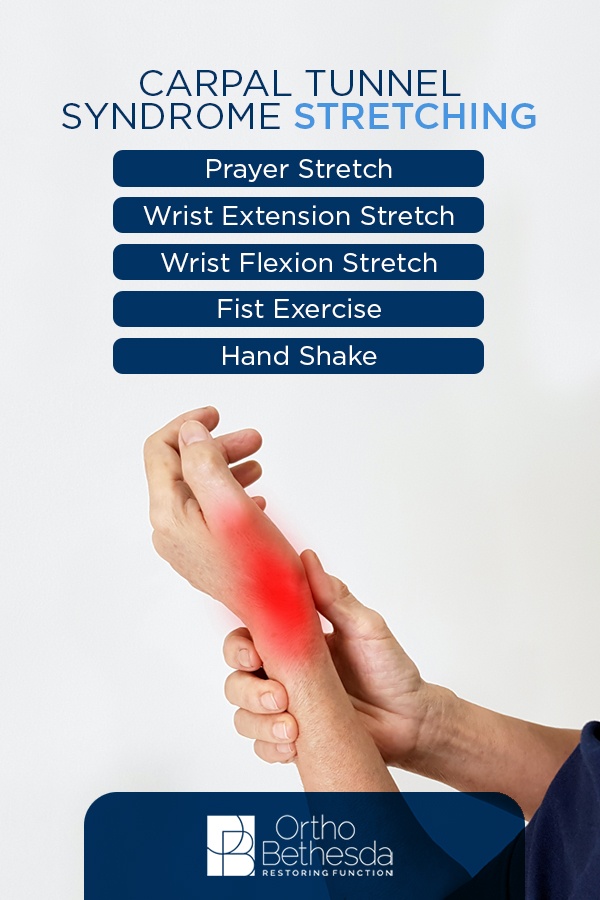
Prayer Stretch
You can easily complete this stretch at your desk. Here’s what you’ll do:
- Press your palms together and place them in front of your chest below your chin.
- Keeping your hands pressed together and near your stomach, slowly lower them toward your waistline until you feel stretching under your forearms.
- Hold the position for 15 to 30 seconds and repeat two to four times.
Wrist Extension Stretch
Try this simple stretch provided by the American Academy of Orthopaedic Surgeons (AAOS):
- Extend your arm in front of you and bend your wrist back in a “stop” position.
- Place your opposite hand across your palm and gently pull back until you feel stretching in your forearm.
- Hold the position for 15 seconds, repeat five times, then switch to the other arm.
Wrist Flexion Stretch
This stretch provided by the AAOS asks you to push your fingers toward your body. Here’s what you’ll do:
- Extend your arm in front of you and bend your wrist with your fingers pointing down.
- With your opposite hand, gently push your hand toward your body until you feel the outside of your forearm stretch.
- Hold the position for 15 seconds, repeat five times, then perform the stretch on the other arm.
Fist Exercise
Here’s a simple exercise you can try standing or sitting down:
- Hold out your hand and extend your fingers, keeping them straight.
- Bend your fingers to form a “hook” fist.
- Return to a straight position.
- Bend your fingers to form a full fist.
- Return to a straight position.
- Make a fist while keeping your thumb straight.
- Return hand and fingers to a straight position.
Hand Shake
A simple way to stretch your muscles while you’re at work is to shake out your hands as if you just washed them and are trying to air dry them. This nearly effortless motion helps loosen up your muscles.
How to Test for Carpal Tunnel Syndrome
To test for CTS, your doctor will consider your medical history and examine your wrist and hand. If they suspect you have CTS, they may perform other tests to confirm their diagnosis.
- Tinel’s sign test: This test involves tapping on your median nerve near your wrist to see if it causes tingling or pain. If it does, your doctor may suspect you have CTS.
- Phalen’s test: During this test, the doctor will ask you to flex your wrists to see if it causes symptoms.
- X-ray: Your doctor might order an X-ray to rule out other causes of your pain, such as a fracture or arthritis.
- Nerve conduction study: A nerve conduction study assesses the flow of electrical signals that move through the median nerve and into the hand muscles. A slower flow of electricity may be the result of CTS.
- Electromyography (EMG) testing: EMG testing examines muscle functioning. It can detect the smallest loss of muscle functioning and identify early nerve damage.
Carpal Tunnel Syndrome Treatment
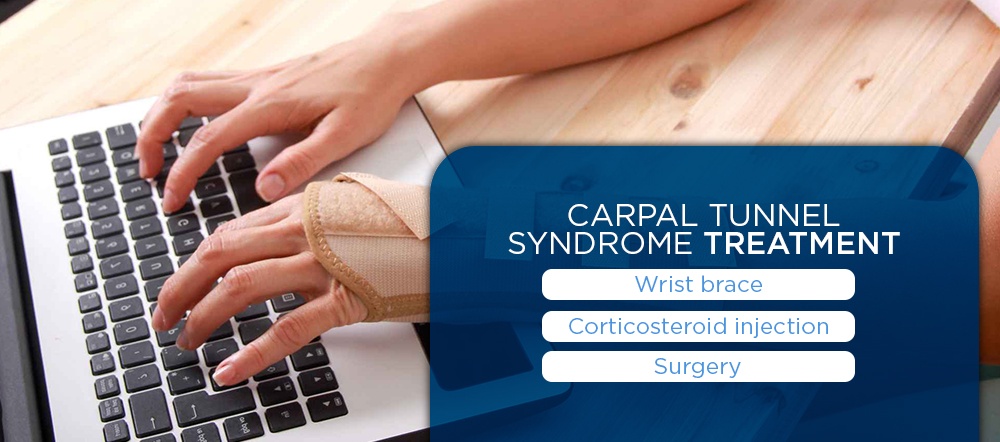
If you’re experiencing pain in your wrist or hand, it’s best to have your doctor check it out. Untreated carpal tunnel syndrome could lead to weakness in your fingers and make it challenging to coordinate movements. It can also become more painful over time.
If you have mild CTS, there are many things you can do to relieve symptoms and stop it from progressing. Often, treatment can eliminate mild CTS symptoms. If you have severe CTS that interferes with daily activities, your doctor may recommend surgery. Here’s what treatment typically entails.
- Wrist brace: The first form of treatment for CTS usually involves wearing a wrist brace or splint. Your doctor might recommend a brace, especially if your symptoms cause pain at night that keeps you from sleeping. For individuals with mild CTS, wearing a wrist brace and taking frequent breaks can be enough to resolve symptoms.
- Corticosteroid injection: Your doctor might administer a corticosteroid injection in addition to recommending a splint. This injection can reduce swelling and inflammation in the carpal tunnel, which reduces the pressure on the median nerve.
- Surgery: If treatments do not relieve symptoms, your doctor might suggest surgery. During surgery for CTS, the surgeon will cut the ligament that is pressing on the median nerve. The surgeon will also check for other conditions that may be causing nerve issues during the procedure. For most patients, surgery is an effective treatment for CTS.
We Can Help at OrthoBethesda
Feeling pain anywhere — whether it be in your hand, wrist or another part of your body — can be worrisome, especially if it’s recurring. While you may be experiencing the symptoms of carpal tunnel syndrome, a different ailment may be causing your discomfort. A physician who specializes in orthopedics can determine the cause of your pain, so you can take the proper steps toward feeling better.
At OrthoBethesda, our team of highly skilled hand and wrist specialists have dedicated their practice to helping patients understand their symptoms and move toward a pain-free life. Our physicians will first identify the issue causing your pain, then initiate various therapies to find a solution that works. If treatment does not improve your symptoms, we will discuss surgical options with you. We’ll stay with you through surgery and during post-operative care to ensure you’re recovering as you should.
Carpal tunnel syndrome can be an excruciating condition, but you do not have to cope with it alone. The sooner you seek treatment, the better the outcome. If you live in Bethesda, Arlington or anywhere in the Washington, D.C., metropolitan region, let us help at OrthoBethesda. For more information or to schedule an appointment, please contact us today.

